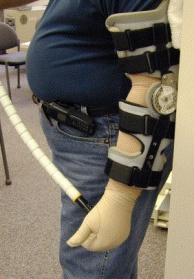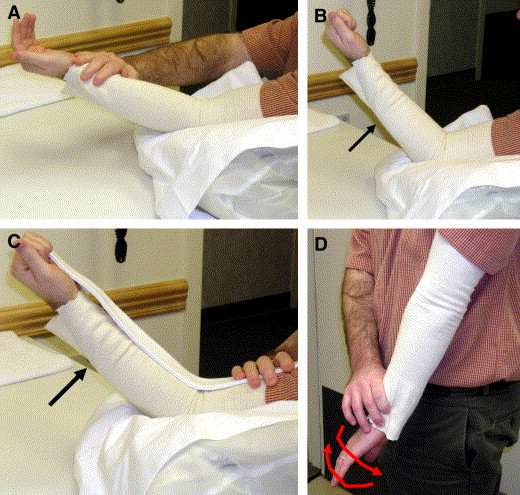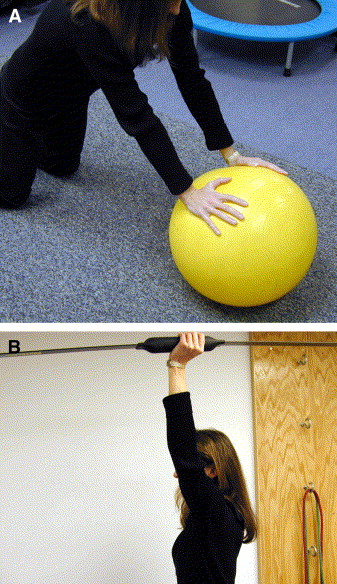Rupture of the Triceps Brachii muscle
( This page under up-dating , sorry for any inconvenience)
Definition/Description[edit | edit source]
A rupture of the distal triceps is the most uncommon rupture in the upper extremity, namely less than 1% of all the upper extremity tendon injuries.[1][2]
Epidemiology / Etiology[edit | edit source]
We can associate triceps ruptures with a traumatic injury or sometimes it occurs after a surgical procedure where the triceps was reattached. For example some case reports confirm triceps ruptures after following total elbow arthroplasty. There are some predisposing factors for triceps rupture like : systematic endocrine disorders, renal failure, anabolic steroid use, local steroid injection, and chronic olecranon bursitis. When the triceps is placed in an unfavorable loading condition like lowering a very heavy object, the triceps can be at risk. The patient describes often an unexpected “pop” or giving way. Subsequently the patient has pain and weakness in the extremity. [1]
Clinical presentation[edit | edit source]
A patient with a triceps rupture can have posterior elbow pain, triceps weakness, a swelling and a palpable defect in the tendon. [2]
When the patient is unable to extend his arm against gravity, you can expect a complete triceps rupture. A palpable defect is not always present, but sometimes can be found in the posterior arm. Swelling and echymosis are other nonspecific findings. [1]
Differential diagnosis[edit | edit source]
- Fracture[1]
- Joint dislocation[1]
- Intramuscular tear[1]
Physical therapy management[edit | edit source]
Level of evidence : B
Patients with a complete rupture must be treated surgically. However when there is a partial rupture, the patient can be treated non-surgically. Although some patients will experience persistent weakness. [1][2]
So when the patient has a partial rupture it’s often treated conservative by splinting the elbow for four to six weeks. The immobilization was followed by range of motion exercises. Six months after the injury, the full strength and ROM was achieved.
The treatment after triceps surgery contains several steps :
A) Protected phase :
1) Splinting following triceps repair
After the repair of the triceps due to surgery, the elbow is immobilized in a long arm splint initially, thereby the elbow is placed in 30 – 45° elbow flexion with the forearm in neutral position and the wrist is often supported. There is a huge variability in recommendations for management after the operation. But the postoperative position is decided by the surgeon, based on tension and quality of the tendon repair, other injuries and the medical history of the patient. This position is also unique to each patient. [1]
A hinged splint can be used after triceps repair if early controlled motion is desired. This splint blocks elbow flexion on the one hand, on the other hand it allows dynamic/gravity assisted elbow extension. The goal is a progressive elbow flexion by weekly advancing the range of motion block. So this splint allows passive elbow flexion and active elbow flexion through a range which is defined. When the patient is not exercising , the splint is locked in one position. In this phase patient education is also very important. The patient must be aware of the prohibition for active elbow extension, because this could lead to avulsion or rupture of the repaired tendon. For example : pushing himself out of a chair may not be performed by his operated arm.[1]

When the patient has difficulties with relaxing the repaired muscle or when he is untrustworthy during the performances of the exercises out of a protective splint, in this cases we use a dynamic traction splint.[1]
2) Therapy program
In this phase we can start with early controlled motion, whether the patient uses a static, hinged or dynamic splint.
When the patient has a static splint it’s an absolute must that the patient is reliable, in other words the patient may not cross the limitations for range of motion or may not actively contract the repaired muscle. When the patient not obeys those rules, this might result in tendon rerupture. We can prevent this problem by using a hinged splint, because then there are blocks placed to limit end range and it also assists dynamic motion.[1]
There is not really a consensus in literature about the optimum time frame to begin early controlled motion. In this article the ECM starts from day 10 to day 14 postoperatively. This has some advantages such as : the reduction of pain and edema. As you can see on the photos below, the ECM program contains four exercises namely[1] :
A) full passive elbow extension
B) active and/or passive elbow flexion to 30 °
C) the use of a template splint, to block degree of active flexion
D) passive forearm rotation with the elbow held in extension

The motion performance during the home program can be assisted by the gravity. Increased flexion is allowed with each successive week. The full active elbow and forearm range motion is allowed at week 6. After the operation the patient has often edema in the hand. We can explain this by the fact that the hand is in a dependant position for much of the day caused by the immobilization of the elbow in extended position. Therefore it’s highly recommended to start immediately after the surgery with some exercises like : hand pomping, elevation above the heart level, the use of compressive glove or wrap. [1]
Additional therapy interventions include :
* thermal agents
* therapist assisted motion within range limits
* edema control
* pain management
* scar mobilization
If it is necessary :
* isometric strengthening for the hand and shoulder rotation, abduction and adduction.[1]
It’s very important to be carefully with an elbow flexion combined with end range of shoulder elevation because this will stress the triceps repair. Full-time immobilization is used for three to four weeks, if the patient follows not the ECM program because more protection for the repair is necessary .[1]
B) Progressive motion phase
Six weeks after the operation , the patient begins with active contraction of the triceps. Elbow extension against gravity is definitely emphasized to encourage active motor recruitment rather then using the gravity to assist the extension.
There are some techniques to restore end range of active motion such as [1]:
* place and hold exercises at available end range
* PNF = Proprioceptive neuromuscular facilitation patterns of exercise
* neuromuscular electrical stimulation
It’s possible that treatment is demanded for capsular tightness or joint contractures. This treatment contains[1] :
* thermal agents
* joint mobilization
* sustained positioning
* splints to increase range of motion
C) Strengthening phase
This phase begins 10-12 weeks postoperatively. It may take several months before the strength is returned. It’s highly important that the active range of motion is equal to passive range of motion when starting this phase. Passive limitations can be treated as long as there are still improvements. The fact that this phase starts after 10 – 12 weeks guarantees that the tendon is adequately healed so that it can tolerate the stress exerted by the strengthening exercises. [1]
The strengthening starts with up to 50 % effort isometric contraction of the muscle tendon unit. The effort is determinated by measuring the maximal voluntary contraction (MVC) of the not- operated side with a hand held dynamometer and having the patient exercise up to 50% of MVC. We start the contraction in midrange and later we progress to the end range of motion. If the patient doesn’t develop pain, the effort is increased to the maximum.
These are the exercises for the triceps strengthening :
* positioning the forearm in supination, neutral and pronation to address all three heads of the triceps.[1]
The strengthening program is finally advanced to :
* Isotonic concentric exercises , using :
• Free weights
• Elastic bands
• PNF diagonal patterns
*eventually advanced to eccentric muscle contraction
These two photos demonstrate exercises to complete the stabilization and mobilization exercises.

A : Demonstration of weight-bearing and scapular control exercise to facilitate full limb reconditioning
B: Demonstration of the Body Blade
If there’s a development of pain at the surgical site, the intensity of the strengthening program is immediately reduced.
Sixteen weeks after the operation , sports-specific and work -specific activities begin.[1]
References[edit | edit source]
- ↑ 1.00 1.01 1.02 1.03 1.04 1.05 1.06 1.07 1.08 1.09 1.10 1.11 1.12 1.13 1.14 1.15 1.16 1.17 1.18 1.19 Blackmore S.M. et al, Management of distal biceps and triceps ruptures. Journal of hand therapy, 2006; 19 : 154-169. Level B
- ↑ 2.0 2.1 2.2 Rineer C.A. et al., Elbow tendinopathy and tendon ruptures : Epicondylitis, biceps and triceps ruptures. Journal of hand surgery, 2009 ; 34 A : 566 – 576 Level B






